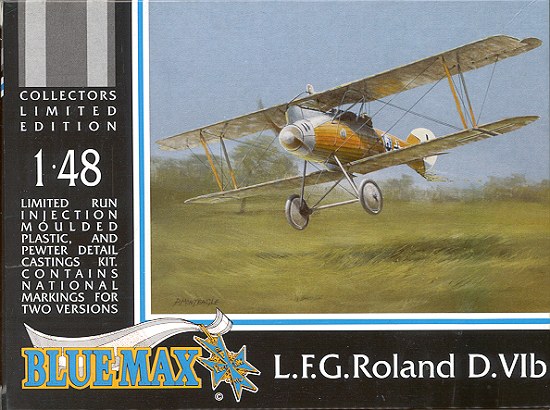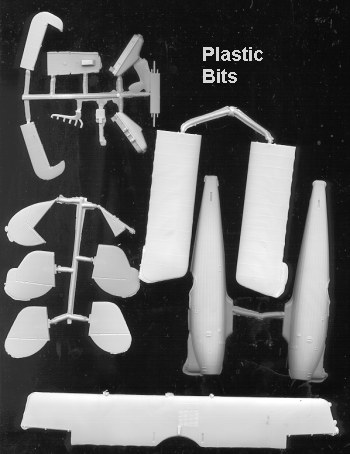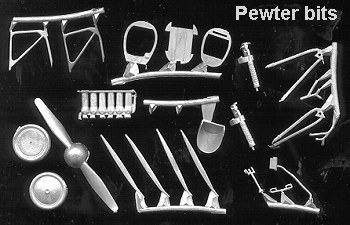
|
KIT: |
Blue Max 1/48 LFG Roland D.VIb |
|
KIT # |
BM 117 |
|
PRICE: |
$49.98 ($44.97 at Squadron) |
|
DECALS: |
two options |
|
REVIEWER: |
|
|
NOTES: |
Short run with pewter parts |

|
HISTORY |
As esthetically pleasing as the
D.VI was, it was not that much of a performance improvement over the
Albatros D.V and was totally outclassed by the Fokker D.VII that entered
service about the same time. The result was that it was used more as a
fighter-trainer in operational squadrons to prepare pilots for the higher
performance Fokkers. Post-war, the US tested an example and used it to
test various camouflage patterns during 1920. Its fate is unknown, but it
was probably destroyed soon after.
|
THE KIT |
 For those of you who
don't know, Blue Max is one of the various 'brands' from Pegasus of
England. They provide a variety of short run kits for enthusiasts and
concentrate on WWI kits in 1/48 scale. For the Blue Max folks, short run
means that the base airframe is in low pressure-molded plastic that is a
bit softer than the norm, with any of the difficult detail parts being cast
in pewter. The detail level on the plastic parts is quite good with crisply
done detail where it is needed. They also do not have the 'hills and
valleys' type of fabric covering on the flight surfaces, which will please
many. The pewter parts are very well cast without the pits and mold
misalignment that one finds with some other (French) kits that offer these
types of detail parts. Both types of material show only a small amount of
mold flash which can be easily removed. The parts are packaged in
small zip bags. I found the more petite or thin metal parts to have been
rather badly misshapen during shipping so some careful tweaking will be
needed prior to use.
For those of you who
don't know, Blue Max is one of the various 'brands' from Pegasus of
England. They provide a variety of short run kits for enthusiasts and
concentrate on WWI kits in 1/48 scale. For the Blue Max folks, short run
means that the base airframe is in low pressure-molded plastic that is a
bit softer than the norm, with any of the difficult detail parts being cast
in pewter. The detail level on the plastic parts is quite good with crisply
done detail where it is needed. They also do not have the 'hills and
valleys' type of fabric covering on the flight surfaces, which will please
many. The pewter parts are very well cast without the pits and mold
misalignment that one finds with some other (French) kits that offer these
types of detail parts. Both types of material show only a small amount of
mold flash which can be easily removed. The parts are packaged in
small zip bags. I found the more petite or thin metal parts to have been
rather badly misshapen during shipping so some careful tweaking will be
needed prior to use.
 Metal is used for the
prop, wheels, guns, seats, struts, engine, cockpit enclosure and some other
minor fittings. The injected parts include optional horizontal stabilizers
for one of the two decal options. The ailerons are provided as separate
items and for those wishing to cut and reposition the rudder and elevators,
this will be quite simple, thanks to the softer plastic used.
Metal is used for the
prop, wheels, guns, seats, struts, engine, cockpit enclosure and some other
minor fittings. The injected parts include optional horizontal stabilizers
for one of the two decal options. The ailerons are provided as separate
items and for those wishing to cut and reposition the rudder and elevators,
this will be quite simple, thanks to the softer plastic used.
Instructions are a single sheet with an exploded view of all the parts.
Thanks to the simplicity of WWI aircraft, this is sufficient. There are
also some well done photos to help in construction of interior parts.
Detail photos and overall shots of completed models are also provided. The
i nstructions have detailed
color information as well as equally detailed decal instructions. Color
info is provided in FS, Methuen and Xtracolor. It is highly recommended
that the Windsock Datafile on this plane be used during construction.
Decals are provided for the insignia and special markings. The lozenge used
will have to come from an outside source, but there are a number of decal
companies that produce very nicely done sheets of this material. No rigging
diagram is provided, but the box art should suffice and I'm sure there is
one in the reference.
nstructions have detailed
color information as well as equally detailed decal instructions. Color
info is provided in FS, Methuen and Xtracolor. It is highly recommended
that the Windsock Datafile on this plane be used during construction.
Decals are provided for the insignia and special markings. The lozenge used
will have to come from an outside source, but there are a number of decal
companies that produce very nicely done sheets of this material. No rigging
diagram is provided, but the box art should suffice and I'm sure there is
one in the reference.
|
CONCLUSIONS |
This is a kit for advanced builders who are used to tackling the challenges often provided by short run kits. However, it does not appear to be that difficult as these kits go so if you are wanting to try your hand at your first WWI short run kit, this one would be an excellent choice.
You can find this kit and many others at

If you would like your product reviewed fairly and fairly quickly by a site that has over 200,000 visitors a month, please contact me or see other details in the Note to Contributors.